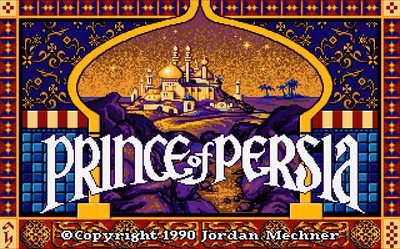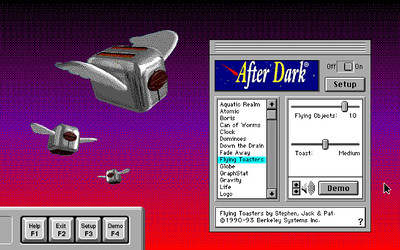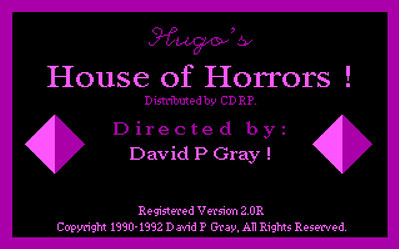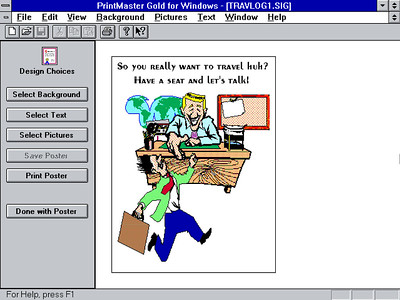A Nintendo Rhapsody Spin-Off
The Computer Files, Folder 1: ExoDOS (MS-DOS and Windows 3.1)
The Computer Files, Folder 2: CD BDEC (Windows 3.1)
The Computer Files, Folder 3: HIGH Memory (Windows 95 and MS-DOS Mode)
The Computer Files, Folder 4: You've Got Mail (AOL and the World Wide Web)
Memories of Doom/IBM 486 (for Folder 1: ExoDOS)
My grandmother and aunt picked up my first computer from a business, to the best of my recollection, known as NET Computers. It was a custom IBM 486/66 with four megabytes of RAM. I knew next to nothing about computers in 1994. So little so that when I began playing SimCity 2000 and noticed the landscape had edges, I thought I needed more RAM to build bigger cities. I quickly upgraded to eight megabytes of RAM. SimCity 2000 remained, of course, unaffected. My aunt gave me a copy of the original SimCity and Where in the World is Carmen Sandiego. The computer itself came with Doom and Epic Pinball pre-installed in MS-DOS. Doom transported players to the one place nobody wants to go, but it was truly something else in 1994.
That computer was plagued with its fair share of problems. It often suffered from disk read errors, and there were even times in which it would fail to boot at all. I eventually had no choice but to take the computer in to be serviced, and in the process, Doom was completely wiped from the drive. It was not long before I became eager to get my hands on the game again. While browsing a small computer shop with dad, I happened to eye a copy of Doom sitting on one of the software shelves. I was curious as to what exactly the term "Shareware" meant on the game's disc and proceeded to ask a clerk about it before making my purchase. I was told that the label was no big deal; that the complete game should be on the disc. Well, imagine my surprise when I came home and found that only Knee-Deep in the Dead was playable from the episode selection screen.
I could only replay Knee-Deep in the Dead so many times. I decided to take advantage of the points system at B.D.E.C. to secure a Toys"R"Us gift card worth $30 from the school's "store" in the cafeteria. If you behaved well and did your work, you earned points that could be spent on various things in said store. I bargained with the lady who supplied the goods, and used the gift card to purchase The Ultimate Doom. Ingenuity is a good talent to possess. The Ultimate Doom contained the three episodes present in the original version of Doom, in addition to a bonus fourth episode entitled Thy Flesh Consumed.
My B.D.E.C. counselor, Dana, was engaged to an employee from Interplay. She knew a lot more about game design than anyone else I had the pleasure of meeting while growing up. She questioned my use of cheat codes, whether it be "19, 65, 9, 17" or "IDDQD." For the fun of a video game should be in the learning curve, not the easy route. Dana made a fair point, but "IDSPISPOPD" is pretty cool for discovering hard to find secrets. Many id Software fans may already know this, but John Romero's gory head is in the final level of Doom 2 behind the Icon of Sin. Only visible with the clipping code "IDCLIP." As for Interplay, I still have a Descent II CD lying around somewhere. According to Wikipedia, it was merely published by Interplay, but it was a fun - if not dizzying - 3D space flight game.
From a previous article on the subject of my IBM 486:
My first PC was a beast. 66MHz of raw computing power, 8 megabytes of memory enhancing RAM, 16-bits of surreal audio processing (Sound Blaster 16) and 2 megabytes of mind blowing onboard video memory. It could run Doom II: Hell on Earth at maximum settings. This PC was originally packaged with MS-DOS 6.22 and Windows 3.1. Later, I upgraded to Windows 95. "Where do you want to go today?"
Playing around with my IBM 486/66 in 1995.
Discussing Doom (Christmas of 1995)

My first piano program. A DOS application titled Sound Blaster Intelligent Organ.

Sound Blaster 16 applications running on Windows 3.1.
NET Computers Information (for Folder 1: ExoDOS)
NET computers was the name of the shop where my grandmother bought my first computer. It was far from a typical shop. It looked like the kind of place that was just being rented out. It had a very upstart feel to it. Office rooms without much of anything in them. Save for a few boxes and various electronic parts. There were a handful of computers on four legged tables near the entry way.
Orchard Dale Reflection 1989 (for Folder 1: ExoDOS)
When thinking back upon Orchard Dale Elementary's computer lab, two words come to mind. Cold and sterile. It was devoid of the usual classroom writing utensils. Occupied instead by thinking machines. Machines that appeared to have one function only. The output of math equations to a monitor. Surely, there was no future in these things.

The Computer Files Text-Based Adventure (ASCII Art)
Karateka Story (for Folder 1: ExoDOS)
B.D.E.C. was a bit behind the times in terms of technology. Their computer lab consisted entirely of Apple IIs in the mid-1990s. As one might expect, most of the software was educational, but they had at least a few games in their library as a reward for completing student tasks on time. Brøderbund's Karateka was one of those games. A game that is perhaps best described as a side-scrolling beat em' up. One of the earliest of its kind. Karateka was designed by Jordan Mechner, who went on to create the original Prince of Persia. The name of this game may have escaped me in the years following my departure from B.D.E.C., but I never forgot the sight of Mount Fuji present throughout many of the game's screens. However, I was likely not aware of the name of said mountain for many years to come.

Karateka on Apple II
Prince of Persia Story (for Folder 1: ExoDOS)
My aunt Lorilee gave me a copy of Prince of Persia shortly after I received my first computer in 1994. She made a set of numbered floppies containing the game's files. It was therefore not a legit copy, strictly speaking. Prince of Persia was designed by Jordan Mechner. The very same Jordan Mechner who designed Karateka five years earlier. Unlike Karateka, Prince of Persia played more like a platformer with bottomless pits, death spikes and various other traps. Every so often, the player would be confronted by an opponent that would then initiate a sword fight. Prince of Persia was, to the best of my recollection, tough as nails. I never managed to finish the game.

Prince of Persia Title Screen
After Dark (for Folder 1: ExoDOS)
This is a tricky entry for The Computer Files. I couldn't remember if I had the Windows 3.1 or MS-DOS version of After Dark. My aunt Lorilee gave me a copy for my IBM 486. I vaguely remember After Dark having its own background (not present in the Windows releases), so it was probably this version.
After Dark included a fairly wide selection of screensavers. It was most famous, of course, for its Flying Toasters.

After Dark for MS-DOS
Hugo's House of Horrors (for Folder 2: CD BDEC)
Hugo's House of Horrors is a text parser adventure game I found in the bargain bin of a tiny computer shop back in 1994. My very first encounter with the genre. It was tough for me to play at the time because my spelling was quite primitive. It proved to be a learning experience. Typing "look" can sometimes help determine the names of items that are present on-screen, but it can also sometimes not be very helpful at all. I later came across Hugo 2: Whodunit? via another bargain bin-type scenario. Hugo 2 is a murder mystery set after the events of the first game. I'm almost certain these are the games in which I first learned the words "pantry" and "cupboard." And more than likely a number of other words for common household objects. As adventure game whizkid Conrad Sheldon would say, "It's a game about this guy named Hugo and he's facing the wrong way."


Hugo's House of Horrors with Hugo facing the wrong way.
Corncob 3D (for Folder 2: CD BDEC)
Here's another computer game from my collection that seems deserving of a place in The Computer Files. It's Pie in the Sky's Corncob 3D. An early DOS-based flight simulator with combat elements. I honestly had more fun crashing the plane into the runway than I did taking off and landing.


Corncob 3D (Floppy Diskette and Game Screenshot)
The Eggo Project (for Folder 2: CD BDEC)
In 1994 or so, I began to use Microsoft Write (and later, Microsoft WordPad) to catalog strange and mostly irrelevant stories. These word processors offered rich text formatting, including multiple fonts and text decorations per document. My younger brother often worked alongside me to write these stories. It was entitled The Eggo because many of the stories were about Eggos and one man's struggle to overcome his addiction to them. We printed our collection of stories and passed them around to unsuspecting readers. Remember, this was before the Internet. Goal Books was our publishing label. It was four whole years before I used that name for my independent computer game projects.
Watch out for these other Books from Goal Books heading your way.
Eggzilla and the 3 Eggos
Gone to Sandyeggo
Revenge is Sweet

The Eggo Cover (Microsoft Write)
Travel Log Project (for Folder 2: CD BDEC)
Travel Log was inspired by Where in the World is Carmen Sandiego, but instead of chasing a criminal, you chased your dream vacation. It was not a game exactly. It was a kind of "choose your own adventure" that I printed onto paper. A travel agent sets you up on a vacation. Where you go next is up to you. It was created using PrintMaster Gold.
"A travel agency resides on a neglected street corner. Early morning turns to afternoon. Inside, a travel agent is filing away vacation plans when a would-be tourist enters the office. The travel agent quickly retrieves his vacation plans again."

Travel Log Sample Scene

Travel Log Logo (New)
Taxi with Zagat Surveys (for Folder 2: CD BDEC)
Before GPS or Google Maps, there was Taxi with Zagat Surveys. A set of floppy disks with map data for Los Angeles, San Francisco, New York and other cities. Each floppy contained a different city. After choosing a start and finish location on the map, a taxi cab appears and loops around a small window as the drive distance and taxi fare are calculated. I more than likely mistook this application for a game when I found it in a bargain bin in the mid-1990s.

Taxi with Zagat Surveys

Taxi with Zagat Surveys (About Screen)
Just Joking (for Folder 2: CD BDEC)
This is another unusual pre-Internet application. Just Joking for MS-DOS. It featured jokes, quotes and other pieces of writing presented within a DOS Editor looking user interface.

Just Joking Index
Survival: Jurassic Park (for Folder 3: HIGH Memory)
Of all my weird writing projects from the 1990s, Survival: Jurassic Park is likely one of the weirdest. I wrote it in MS-DOS Editor during summer school of 1997. It sees Mr. Hammond, who I referred to as Dr. Hammond for one reason or another, eaten by a T-Rex at one point. I would like to think he's maybe still alive (like Bowser's Inside Story).
At another point in the story, a zookeeper is called out to investigate a disturbance at the Los Angeles Zoo. As he gets closer to the enclosure, he realizes that the animal inside is not one of their own, but in fact a Velociraptor. That might have made for a better opening act.

Survival: Jurassic Park (MS-DOS Editor)
Quest for Glory IV: Shadows of Darkness (for Folder 3: HIGH Memory)
Having never played the previous three entries in the Quest for Glory series, I knew not what to expect from Shadows of Darkness. I had however previously played through many of Sierra On-Line's Space Quest and King's Quest games. My memory seems a bit vague, but I more than likely found Shadows of Darkness in a bargain bin (much like Space Quest IV: Roger Wilco and the Time Rippers). A sticker is stamped on the back of the game box that reads, "VALUE PRICED MERCHANDISE - No tech support provided." One of the very first things I noticed about the game was that it was narrated by none other than John Rhys-Davies of Indiana Jones and Sliders fame. I could listen to him go on about caverns for hours. Unlike Space Quest or King's Quest, Quest for Glory employs a turn-based combat system, character classes and skill points. Attributes more commonly seen in role-playing games than in point and click adventure games. Shadows of Darkness is set in the gloomy land of Mordavia, and it would seem that just about everyone you meet there is a bit peculiar. I still remember waiting until after nightfall to break into the Burgomeister's office. Perhaps hoping to learn some dark secret about him. I would eventually come to find myself inside Castle Borgov. A very spooky, and if memory serves correctly, deadly place to be. I honestly cannot recall if I ever finished Shadows of Darkness, but it certainly encouraged me to go back and check out the earlier games in the series.
I played through the entirety of AGD Interactive's remake of Quest for Glory II: Trial by Fire and would periodically play Quest for Glory I: So You Want to Be a Hero. Or as would-be Sierra On-Line mascot and superfan Conrad Sheldon would call it, Hero's Quest for Glory. A combination of the game's original title with the current one.

Quest for Glory IV: Shadows of Darkness (Box and Manuals)

Quest for Glory IV: Shadows of Darkness (Character Creation)

Custom boot disk parameters for games such as Quest for Glory & Space Quest.
Space Ruckus (for Folder 4: You've Got Mail)
Space Ruckus was my first proper computer game (Travel Log being a picture book). I knew very little about game design at the time, so the resulting game was naturally a mess. I am still somewhat fond of the opening title screen sequence, however. Even if ruckus appears to be misspelled.
Nintendo Rhapsody on the subject of Space Ruckus: Following the completion of sophomore year, I anxiously mailed away for a program that would allow me to design and publish my own games. That program was Klik & Play, a multipurpose editor from Clickteam. Developed in the United Kingdom in 1994. I had a laundry list of game ideas in my head, but most of them were far too ambitious. I first tried to create a point and click adventure game starring a group of humanoid felines, inspired partially by Star Fox 64, but everything had to be done completely by hand. The inventory screens, the items, the icon bar and everything else in-between. It then required some creative wrangling with the event editor to make everything work together. I would eventually find a way to make this work for a later game, but for the time being, the ends did not justify the means. I instead turned my attention to a space shooter-type game. I had just recently watched two movies. Lethal Weapon and Millennium. They fused together to form what would become known as Space Ruckus. Bill Grig was a new recruit to the military base orbiting Ralin V, and he was about to have a very bad first day on the job. A full-scale invasion was underway by an alien race known as the Velorians. Bill Grig would need all the help he could get because my programming sucked balls. Those lucky few who were godly enough to finish Space Ruckus were greeted to this Winston Churchill quote I stole from Millennium's finale, "This is not the end. This is not the beginning of the end. It is the end of the beginning." Translation: Sequels were on the way. Bill Grig, by the way, may have acquired his name from Riggs, but he inherited his mustache from Murtaugh.

Space Ruckus (Title Screen)
History of Goal Soft (for Folder 4: You've Got Mail)
Goal Soft was an amateur games company founded in 1998. Goal Soft created a variety of games via Klik & Play (and later, The Games Factory and RPG Maker 2000). The name originated from an image that was discovered while using a Windows 3.1 program entitled PrintMaster Gold. The image consisted of an arrow through a dartboard with the word 'goal' written on it. A few rare Goal Soft logos feature just such a dartboard.
Goal Soft, at its roots, was a group of people who loved making games. Many of the games did not meet with success, but that did not stop them. The team had an unbreakable spirit. They were always willing to try again.
Every goal begins as an idea born of the imagination. Bringing that idea to life requires dedication, care and perhaps even a spark of love.

DARTGOAL.WMF

Goal Soft Collection Wallpaper (2001)
Roger Wilco and the Windows Accessories (for Folder 4: You've Got Mail)
While attending California High School, I happened to find myself in study hall one afternoon catching up on classwork. It was a relatively compact study hall with only a handful of desks, but there were a few computer terminals on the left side of the room. When I was finished with my classwork, I made haste for one of those computers. My home computer had certainly spoiled me. I was running Windows 95 with the latest bells and whistles. These computers, however, were still running Windows 3.1. While poking through the various accessories in Program Manager, I discovered something very interesting. A program labeled simply "Sciwv." The icon was unmistakable. It read SQIV. It was none other than Space Quest IV: Roger Wilco and the Time Rippers. The Windows version! One could surmise that another rebellious student had installed it on this computer. It was clever hiding it under the Accessories window. A teacher would never realize that it was in fact a game. I mean, an educational program about waste management! [*guilty sounding whistling*] It is a shame that I never had the chance to meet this other student. I imagine we would have been the best of friends.
The below screenshot is a recreation I whipped up in my Windows 3.1 virtual machine.

Windows 3.1 Program Manager with Space Quest IV
BUILD Editor (for Folder 5: Click and Play)
While poking around my Goalsoft backups for .MAP files, I happened across a few BUILD levels that I had created in 1999 and 2000. These levels were not nearly as complex as the ones I remember creating in the mid-1990s. By the late 1990s, I primarily used BUILD for basic 3D prototyping.

Build Editor (Map Selection)

BUILD Editor (EOTH.MAP)
No comments:
Post a Comment